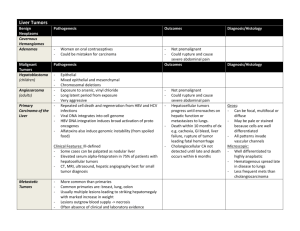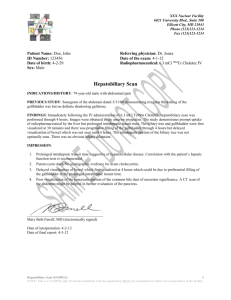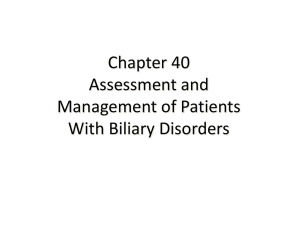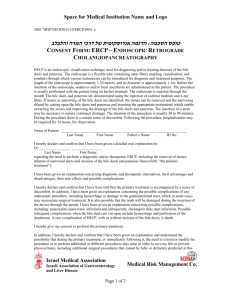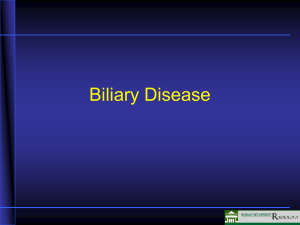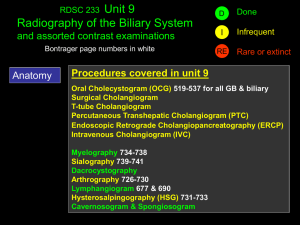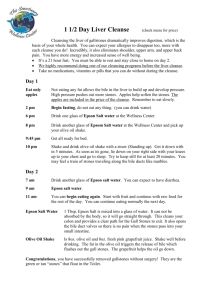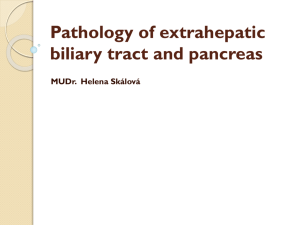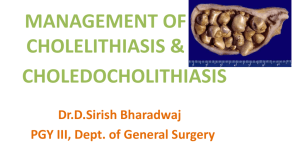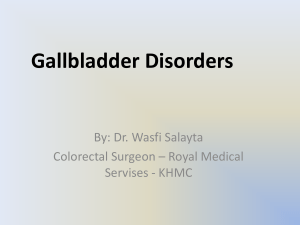Biliary stone disease - University Hospitals Birmingham NHS
advertisement
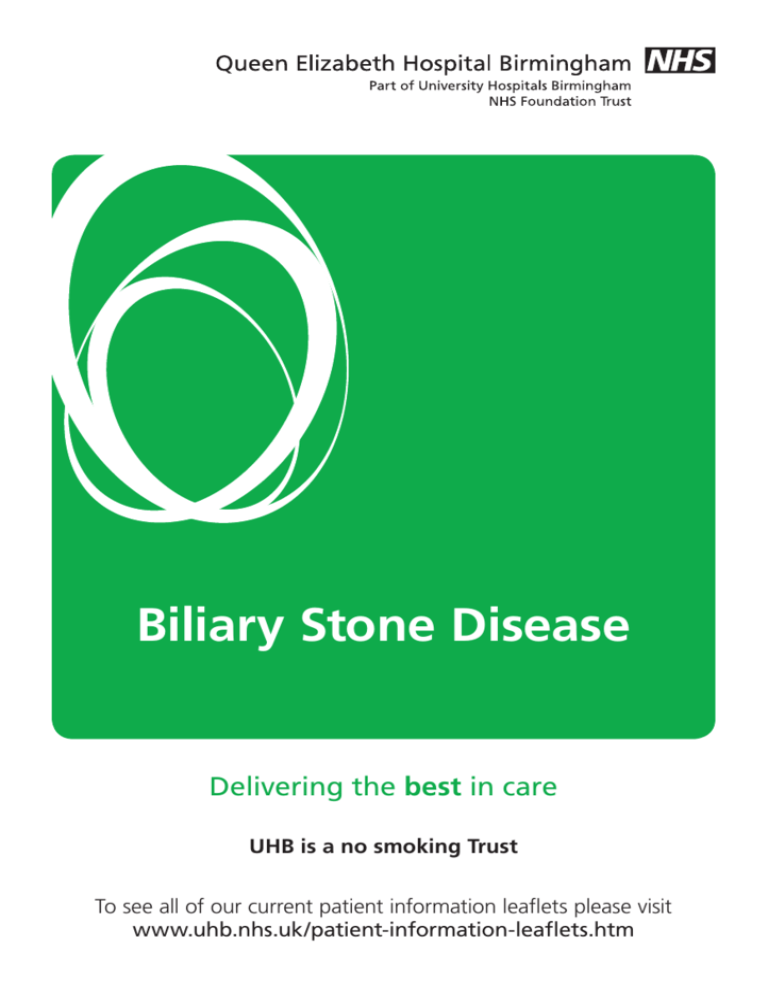
Biliary Stone Disease Delivering the best in care UHB is a no smoking Trust To see all of our current patient information leaflets please visit www.uhb.nhs.uk/patient-information-leaflets.htm You have been diagnosed with gallstones and you may have stones in your biliary tree as well. This leaflet should help you understand what that means and what your treatment options are. What are gallstones? Gallstones are small solid objects that form in the gallbladder or in the biliary tree. The stones are most commonly formed of cholesterol from the bile. Gallstones are very common with more than 1 in 15 people having them, although they do not always cause symptoms. Gallstones occur twice as often in women compared with men. Being overweight also increases the chance of gallstones forming. What is the biliary tree? Bile is produced in the liver and is stored in the gallbladder. Bile flows from the liver to the gallbladder and then into the gut through the biliary tree. The biliary tree is made of a number of ducts and stones can form or get stuck along these ducts. Liver Stomach Pancreas Biliary tree Gallbladder 2 | PI_1323_02 Biliary Stone Disease Duodenum Small (bowel) intestine What are the symptoms? Pain • This is due to a blockage by the stone. It may last for a few hours and then go away (known as biliary colic) If the gallbladder becomes irritated or infected the pain can last for longer (known as cholecystitis) • The biliary tree can also become irritated if a stone is stuck in the ducts (known as choledocholithiasis). This can cause jaundice • Stones in the bile ducts can block the drainage of the pancreas causing it to become inflamed and painful. This is known as pancreatitis Jaundice You may notice your skin or the white of the eyes becoming yellow. This is called jaundice. You may notice that your skin is itchy, your urine is a dark colour and your stool is pale in colour. This is due to the stone blocking the bile ducts and stopping bile passing into the gut. Fever If you have a temperature or get the shakes there may be an infection (cholangitis). You should see your doctor urgently. What tests to expect Before seeing the doctor you may already have had some of these tests. The doctor will tell you what is necessary. You may require: • Blood tests – these can be done at your clinic appointment • Ultrasound – this is a simple and quick scan of your tummy (abdomen). It involves having some gel put on your abdomen and a scanner moved over your skin to look inside. The scanner uses sound waves that are harmless to produce an image • MRCP – Magnetic Resonance Cholangiopancreatography. Using an MRI Scanner images of your biliary system can be formed. This involves lying still on a table as the table slides into a tube that takes the pictures. The scanner uses strong magnets to produce the PI_1323_02 Biliary Stone Disease | 3 images. You should remove all metal from your body before going for an MRI scan If you have any metal inside your body (e.g. Pacemaker, stent, joint replacement) you must tell a member of staff before the scan. What treatment is available? If the tests show gallstones in the gallbladder or biliary tree then the doctor will discuss the treatment options with you. Gallstones in the gallbladder without symptoms does not need treatment. If treatment is required the following options are available: ERCP – endoscopic retrograde cholangiopancreatography This method of removing the stones in your bile ducts uses a small tube (an endoscope), the size of your small finger. This tube is passed down your throat, through your stomach and into the gut. From the gut a dye is injected into the biliary tree and X-ray images are taken to locate the stones. The stones can then be removed. In 5% of cases the procedure is not successful and may need to be repeated or you may require a different treatment option. For more information please ask for a copy of the ERCP leaflet. PTC – percutaneous transhepatic cholangiography In some patients PTC is the best method of treatment or you may undergo this procedure if the ERCP is unsuccessful. In this procedure a needle is inserted through the skin and passed through the liver. Dye is then injected and X-ray images are taken to show where the stones are. The stones can then be removed and the bile drained from the biliary tree. A drain may be left in after the procedure. For more information please ask for a copy of the PTC leaflet. 4 | PI_1323_02 Biliary Stone Disease Gallbladder Surgery If you have symptomatic stones in the gallbladder you are likely to be offered a laparoscopic (key hole) cholecystectomy (gallbladder removal). On the day of the operation • Do not eat from midnight the night before (unless told otherwise) • Only take medication you are told to take on the morning of your surgery • Attend the Ambulatory Care department (unless told otherwise) • You will need to have signed a consent form before the operation What does this operation involve? For this surgery you will have a general anaesthetic. This means you will be asleep during the surgery. Four small cuts (1-2 cm long each) will be made on your tummy and then gas will be used to inflate your tummy. The gallbladder containing stones will then be removed through one of the small cuts. You may then have a drainage tube connected come out through your skin. You will wake up with this connected to a bag and this will stay in place for a few days. If the bile ducts need to be opened to remove stones, a drainage tube from the bile ducts will stay in place for a few weeks. The small cuts will be stitched up at the end of the operation. The operation usually lasts 1-2 hours. What can go wrong? All operations carry risks of complications, for this operation they are as follows: • Pain – after keyhole surgery shoulder pain is common but usually lasts less than one day. The pain is due to the gas used during the operation PI_1323_02 Biliary Stone Disease | 5 • Infection – infections can occur at the wound sites, where the stones were removed, around drain sites and in the lungs • Bleeding • Bile Leak – as the bile duct has been cut it can leak after the operation. Usually this settles but occasionally requires another procedure to correct • Bile duct injury – this is a serious but rare complication which involves the bile tubes being damaged. A reconstruction will be needed and may be done at the same operation. To avoid this complication, surgeons will opt to convert the procedure from key hole to open surgery if the anatomy is not clearly seen • Deep Vein Thrombosis (DVT) – these are blood clots in the legs that occur more commonly after keyhole surgery. You will be given an injection and asked to wear compression stockings to prevent this • Pulmonary Embolus (PE) – this is when a blood clot (DVT) travels to the lungs. PE causes breathing problems and can cause death Please ask for the Laparoscopic Cholecystectomy leaflet for more information. After the operation You will stay in hospital for 1-4 days. You should avoid strenuous activity after the operation for up to 2 weeks. • Pain – your tummy may be uncomfortable. For this you will be given pain relief medication to take home • Work – returning to work will depend upon how physically demanding your job is. Usually patients are able to return to work 2-4 weeks after the operation • Driving – your ability to drive will depend on how comfortable you are and if your seat belt causes pain. You should be able to drive within 2 weeks • Eating – your digestion and food absorption should be normal after gallbladder removal 6 | PI_1323_02 Biliary Stone Disease Looking after your wounds You will be given shower-proof dressings to cover the wounds and allow you to wash after the operation. This is needed for one week. The stitches are usually dissolvable and so do not need to be removed. You will be told if you need to have them removed. Check-ups You will require follow-up with your doctor to check your progress and remove the drain if you have one. Open surgery This may be needed if you have had previous abdominal surgery or have certain pre-existing medical conditions or the gallbladder is swollen making key hole surgery difficult. This operation is very similar to the keyhole operation. The main differences are: • The cut on your tummy will be longer • Your stay in hospital is likely to be longer, often 4-5 days on the ward • You are likely to require more pain relief • Your recovery will take longer. It often takes 6-8 weeks to return to work and 4 weeks to be able to drive Helping to reduce symptoms Avoiding fatty foods can help to reduce the pain from gallstones and can make attacks occur less often. Future treatment – After ERCP or PTC If you have a ERCP or PTC to remove bile ducts stones, you are likely afterwards to need your gallbladder removing to prevent the stones re entering the bile ducts from the gallbladder . This will either be PI_1323_02 Biliary Stone Disease | 7 done at a future date or the same time (if you are having surgery). Please ask for the Laparoscopic Cholecystectomy leaflet for more information. Visit a doctor urgently if: • You have severe pain • You have a temperature • You become shaky or shivery You can visit your GP, contact one of the telephone numbers below or if out-of-hours visit Accident and Emergency. For more information British Liver Trust: www.britishlivertrust.org.uk The Trust provides free monthly health talks on a variety of medical conditions and treatments. For more information visit www.uhb.nhs.uk/health-talks.htm or call 0121 371 4323. Liver Services Queen Elizabeth Hospital Birmingham Mindelsohn Way, Edgbaston, Birmingham B15 2GW Ambulatory Care: 0121 371 3100 Ward 726: 0121 371 7303/7304 Surgical Liver Registrar (ask switchboard): 0121 627 2000 Liver Outpatients Department: 0121 371 4414 PI15/1323/02 Author: Mr John Isaac Date: July 2015 Review date: July 2017

